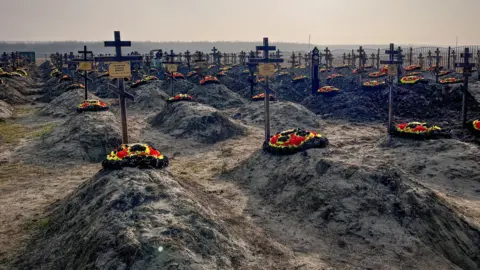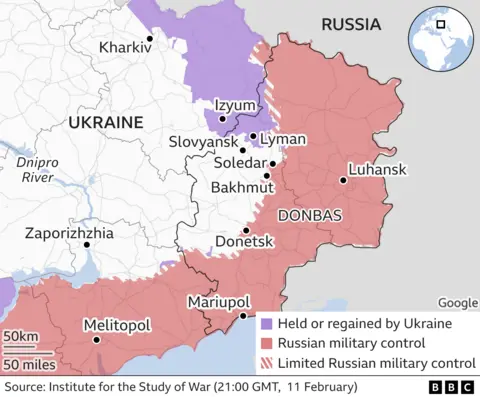Ukraine War: Over 30,000 Wagner fighters injured or killed in Ukraine, says US
 Reuters
ReutersOver 30,000 mercenaries fighting for the Russian paramilitary Wagner Group have been killed or injured since the Ukraine war began, US officials say.
White House spokesman John Kirby said the group had suffered significant losses in recent weeks, with about 9,000 fighters killed in action.
Wagner has recruited heavily in Russian prisons, and Mr Kirby said most casualties were untrained convicts.
Despite the casualties, Wagner has made gains around the city of Bakhmut.
Some of the fiercest fighting of the war has taken place around the eastern city, with Wagner mercenaries heavily involved in Russian efforts to capture it.
Ukrainian troops say Wagner fighters had been sent into attacks in large numbers over open ground, and a Ukrainian army spokesperson said Moscow had failed to evacuate wounded and dead soldiers - leading to "places where their bodies are just piled up".
Capturing Bakhmut could allow Russia to make advances to bigger cities further west, like Kramatorsk and Slovyansk.
However, Mr Kirby - the US National Security Council spokesman - suggested further advances could prove difficult given the gains made in Bakhmut had taken months to achieve and come at a "devastating cost that is not sustainable".
He also questioned the military significance of the city.
"It is possible that they may end up being successful in Bakhmut, but it will prove of no real worth to them because it is of no real strategic value," Mr Kirby told reporters.
Elsewhere, UK intelligence officials have estimated that Russian regular forces and Wagner troops may have suffered between 175,000-200,000 casualties - including 40,000-60,000 deaths.
The high number of deaths was "almost certainly" due to "extremely rudimentary medical provision", the UK's defence ministry said.
The Wagner Group was much smaller before the war, with just 5,000 fighters, most of whom were experienced former soldiers.
It started recruiting tens of thousands of fighters last year - largely from prisons, according to the US - as Russia had trouble finding troops for its invasion of Ukraine. Half of those convicts have probably been wounded or killed, UK officials say.
But last week, Mr Prigozhin, the group's founder, announced it would stop recruiting in prisons. The move followed longstanding tensions between Wagner and the Russian military.
"The number of Wagner units will decrease, and we will also not be able to carry out the scope of tasks that we would like to," he said.
Mr Prigozhin has blamed Moscow's "monstrous bureaucracy" for slowing down progress in Ukraine, and accused the Russian army of unfairly taking credit for previous Wagner successes.
Wagner is believed to have started operations in 2014 in the annexed Crimean Peninsula and has since operated elsewhere in Ukraine, in Syria and across Africa. It has been accused of brutality and war crimes.

